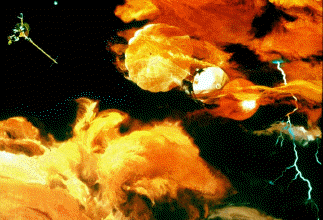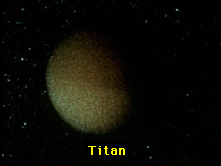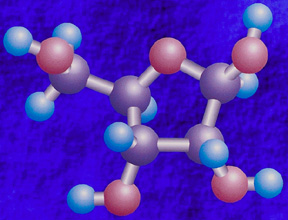This is a drawing of the Galileo probe exploring the environment of Jupiter.
Click on image for full size
Image from: The Jet Propulsion Laboratory
Can there be Life in the Environment of Jupiter?
Jupiter's atmospheric environment is one of strong gravity, high
pressure, strong
winds, from 225 miles per hour to 1000 miles per hour, and cold temperatures of -270 degrees to +32 degrees (freezing temperature). These winds make it hard for life forms to have "peace and quiet".
The region where it is 32 degrees sounds OK, but where the temperature is 32 degrees, the pressure is about the same as it would be if you were a couple miles below the sea on Earth. This region is probably within Jupiter's liquid region. The air of Jupiter is definitely a region that is well below freezing temperatures!
In the atmosphere there are at least three known cloud decks of ammonia, ammonia-combined-with-sulfur, and water, perhaps even made of huge droplets.
There is energy in the environment from lightning, ultraviolet light, and charged particles.
Jupiter's interior possesses an environment of pressures as great as three million times the sea-level pressure on earth, and temperatures as high as 10,000 degrees.
Overall, this environment sounds very unfriendly to life as we know it on earth.
You might also be interested in:

The striped cloud bands on Jupiter are certainly not as straight as they appear to be in this picture! The picture shows that the striped pattern is divided into belts and zones. The belts and zones of
...more
Jupiter's atmospheric environment is one of strong gravity, high pressure, strong winds, from 225 miles per hour to 1000 miles per hour, and cold temperatures of -270 degrees to +32 degrees (freezing temperature).
...more
In July, 1996, it was announced that Dr. David McKay, along with a team of scientists at Johnson Space Center (a division of NASA), had discovered possible fossils of bacteria in a meteorite named ALH84
...more
Saturn's atmospheric environment is one of strong gravity, high pressure, strong winds, from 225 miles per hour to 1000 miles per hour, and cold temperatures of -270 degrees to +80 degrees. With winds
...more
Titan's atmosphere is a lot like the Earth's, except that it is very cold, from -330 degrees to -290 degrees! Like the Earth, there is a lot of Nitrogen and other complex molecules. There also may be an
...more
Autotrophs are organisms that can "make their own food" from an inorganic source of carbon (carbon dioxide) given a source of energy. Most autotrophs use sunlight in the process of photosynthesis to make
...more
In the warm primordial ocean, aggregates of amino acids, proteins, and other hydrocarbons came together into a form called *coacervates*. Amino acids will spontaneously form coacervates in the same way
...more














